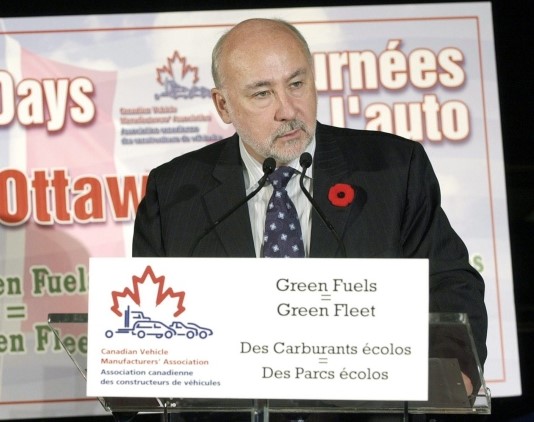OTTAWA – The Canadian auto industry wants the country’s federal government to recycle payments made through its carbon-tax system back to Ontario’s automotive manufacturing sector, so it can reduce emissions and related energy costs.
Executives want the government to hasten a detailed announcement on how the system will work, so the industry can plan and mitigate costs.
Mark Nantais (below, left), president of the Canadian Vehicle Manufacturers’ Assn. (CVMA), wants the information to come in May – five months after the Jan. 1 retroactive introduction of charges for heavy industry, such as the auto sector.
These are essentially a cap-and-trade system, with businesses having to meet a standard regarding carbon emissions. If they breach them, they will pay an anticipated C$10 ($7.43) per metric ton (1.1 ton) of CO2 or equivalent greenhouse gases (CO2e) in 2018, increasing by C$10 per metric ton of CO2e each year to C$50 ($37.15) per metric ton of CO2e in 2022.
If their emissions decline, they earn carbon credits to trade with other manufacturers whose emissions exceed the standard or use them to invest in their own pollution-reduction measures.
This federal system replaces a past cap-and-trade system that had operated in Ontario but was dumped last July by the then newly elected conservative government of Premier Doug Ford. Under the federal government’s carbon policy, provincial governments had been allowed to design their own GHG-reduction policies, if they complied with federal standards. But with the Canadian government predicting Ontario would release approximately 48 million metric tons (53 million tons) more carbon pollution annually in 2030 than if the provincial cap-and-trade system had been retained, it imposed its federal carbon tax.
The CVMA has been pushing the government to avoid aggressive carbon targets for the auto sector, hoping it will allow manufacturers to emit up to 90% of the average for the industry before making carbon payments. Until now, the federal government has indicated this level will be set at 80%, except for special sectors (such as cement and steel) that face strong competition from other countries with less onerous carbon rules, such as the U.S. and Mexico.
Nantais argues Canada’s auto sector is one such industry: “Canada is a high-cost jurisdiction,” he tells Wards. Its plants have electricity costs double or triple those of competing plants in parts of the U.S. Additional carbon-tax costs can hurt, given companies have limited money for retooling and reinvestment and may switch production internationally, Nantais says.
“We have a high threat exposure and operate in a high-cost jurisdiction – so any new cost may not the be the straw that breaks the camel’s back, but it’s everything in aggregate,” he says.
Such carbon leakage could be counterproductive environmentally; production shifted southward to sites with cheaper electricity may receive fewer financial incentives to practice energy efficiency. Also, these alternative locations’ local power supplies may be generated from GHG-intensive power sources, such as coal and oil, rather than the hydro, renewables and nuclear common in Ontario.
As a result, the CVMA is calling for the federal government to allow tax-charge payments to be recycled back to the industry, with flexibility on spending policies. Canada’s auto sector has already plucked much “low-hanging fruit” in reducing energy consumption, such as switching to LED lighting, or idling plants not requiring 24-hours-a-day operation, Nantais says.
Other changes could involve large expensive investments, such as building a new paint shop with energy-efficient technology – which could cost C$500 million ($373.5 million) and last for 20 years – and rebates could help fund them.
If rebates are offered, Nantais hopes the money is returned as “quickly and reasonably as possible.”
Jerry Dias, national president for autoworkers union Unifor, agrees: “Carbon pricing should be structured so that funds are recycled back into the industries and companies in order to achieve even stronger environmental outcomes,” he tells Wards.
Under the federal Greenhouse Gas Pollution Pricing Act, an output-based pricing system for emissions-intensive trade-exposed industries will apply to facilities emitting 50,000 metric tons (55,000 tons) of CO2e per year or more.
Meanwhile, under the federal carbon system, fossil-fuel charges have been levied since April 1 in Ontario as well as the provinces of Saskatchewan, Manitoba and New Brunswick, with amounts varying by province and over time. In Ontario (accounting for 14.3 million of Canada’s 37 million people), the 2019 fuel charge on gasoline is C$0.044 ($0.033) per liter.
 Even though this additional tax will be returned to consumers via a “climate action incentive” payment worth C$307 ($228) per family of four in Ontario in 2019, Nantais warns the fuel surcharge could dampen demand for autos in Canada.
Even though this additional tax will be returned to consumers via a “climate action incentive” payment worth C$307 ($228) per family of four in Ontario in 2019, Nantais warns the fuel surcharge could dampen demand for autos in Canada.
Research shows a sustained increase in fuel costs reduces the amount of distance people drive, and what cars they use and buy, he notes.
A Canadian government note says its tax is needed: “Extreme weather events like floods and wildfires are becoming more severe and happening more frequently due to climate change.”
But for Nantais, declining auto production in Ontario because of carbon tax-based costs is also of concern: “There’s a lot to be lost here. There’s a lot of benefit in having an auto industry.”





